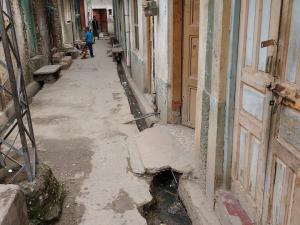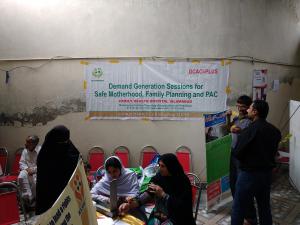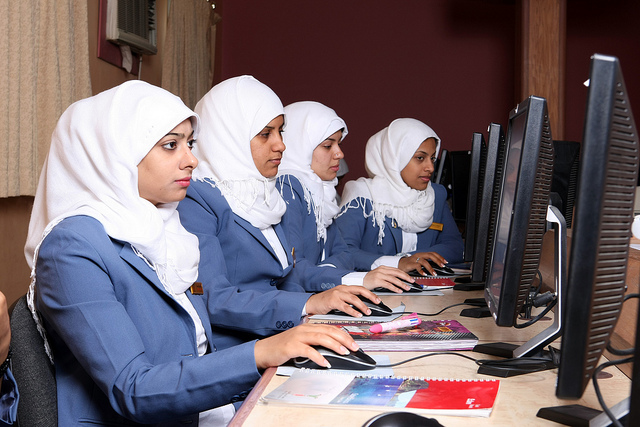If women played the same role in the global economy as men, they could add $28 trillion to GDP by 2025 - increasing it by a quarter, according to McKinsey. All nations have work to do to bring women equal opportunities and pay, but women in many developing countries face especially high barriers to economic empowerment. How to break through them was the subject of a panel discussion at the European Development Days.
Door to Door in Rawalpindi
In an urban slum in northern Pakistan’s Dhok Hassu in Rawalpindi, women rarely leave the house unaccompanied and few have jobs. Another common challenge is getting access to contraception and other basic supplies. 25-year-old Ayesha Durrani, a young leader at the European Development Days, set out to tackle both issues simultaneously, starting small with a project to employ 10 women.

Her model is to train women from the community to sell contraceptive products (condoms and pills), personal hygiene products (mainly sanitary pads) and basic medicines such as rehydration salts, multivitamins and folic acid from door to door. Their average monthly income is around Rs 6000 (€51). For context, “two-thirds of the Pakistani population, that’s more than 100 million people, live on less than 2,500 rupees a month (€21),” said Durrani.
The enterprise gets its supplies free of charge from the provincial government, and the women then sell them on at prices “which vary from product to product, on a scale of Rs 10-Rs 100 (€0.09- €0.90),” said Durrani. “The women get a small commission on every product that they sell (usually around €0.04) in addition to getting a fixed monthly stipend of Rs 3000 (€26) from us.”
In addition to earning a living, the women show their customers and families a positive example that it is possible to earn a living as a woman. “The biggest difference is that of social mobility. These women now move about freely, championing women’s reproductive rights in a community where movement of women was previously at times often looked down upon,” said Durrani. “The daughter of one of these women came up to me and said that when she reaches her mother’s age, she too wants to work in this model. For me, this is a great accomplishment that a daughter has a female role model now, and that too her mother.”
Only 25% of the 57 million women of working age in Pakistan have jobs in either formal or informal employment. For Durrani, the impact of barriers to women’s employment can be measured both on the national scale in terms of lost GDP, and on an individual level.
“Women are economically trapped,’ she said. “For any sort of expenses they have to go to their husbands, they are bound by their husbands. […] Confined to their own houses, to small groups of women, women miss out on socialization, […] they do not have any control,” said Durrani. Work can bring more than economic independence – it can help create self-respect and self-esteem, “better individual wellbeing and better learning,” and more equal domestic dynamics.

The project has so far focused on ten women in a community of 200,000, but Durrani wants to develop it further. She emphasized the importance of training and capacity development, alongside creating jobs. “Many women in Pakistan don’t have their own bank account or basic financial literacy,” said Durrani. “It’s not enough to put money in their hands – they need to know how to use it profitably - they need to know how to invest it and spend it.”
“The eventual aim is to make this a replicable model so that various other communities can also benefit from it. Essential for it to work is a public-private partnership between local NGOs working in the field and the local government, as the onus on the latter is enormous in Pakistan’s development landscape,” said Durrani.
Female Entrepreneurship in Morocco
Asmaa Morine Azzouzi, vice president of the Association des Femmes Entrepreneurs au Maroc (l’AFEM), a network of female entrepreneurs in Morocco, sees entrepreneurship as a key solution to help women enter the workforce.
“In Morocco, 50-60% of women pursue higher education, but you see that only 26% get jobs. It’s not normal – it’s not a lack of talent,” said Azzouzi. She emphasized the difficulty many women face in balancing their professional and personal responsibilities, especially after having children.
Azzouzi called for “a favourable environment to help women return to work after having children, including with childcare or public crèches, and equal pay.” Enterprises run by women are often more progressive on this front, making it “easy to have a family and a salary. Entrepreneurship permits women’s development and allows them to do many things.”
L’AFEM is working with UNIDO, the United Nations Industrial Development Organisation, on a project to promote female entrepreneurship in six countries in the Middle East and North Africa – Tunisia, Egypt, Libya, Jordan, Palestine and Morocco. It has given financial training to over 100 representatives of women’s business associations, and helped map the obstacles faced by female entrepreneurs. Four of these were outlined by Azzouzi: access to a market, access to finance, access to information, and networks.
In the following video, Azzouzi outlines the role the private sector and the government can play to help enterprises to flourish:
Global scale
Such initiatives are needed on a global scale to ensure women are empowered to work, and receive fair pay and equal conditions when they do.
For Phumzile Mlambo-Ngcuka, Executive Director of UN Women, it will be impossible to achieve the Sustainable Development Goals without committed efforts to empower girls and women around the globe. “In most countries only 10% of the resources that are required to implement national plans for women is indeed allocated,” said Mlambo-Ngcuka.
“As a result, the impact of their work is very limited, it is not game changing. It’s almost like women get the crumbs of what is left after the men have eaten, at an international level, at a regional level and at a local level.”
“The one single thing that could be done for the SDGs is to boldly invest in women, and shatter the glass ceiling that is blocking serious and meaningful investment in women,” said Mlambo-Ngcuka.
To advance progress towards this objective, the United Nations Secretary General Ban Ki-Moon set up a High Level Panel on Women’s Economic Empowerment, whose first findingswere presented during September’s General Assembly. The panel looked at the best ways to unlock the power of women to work and achieve financial independence, such as closing the gender pay gap, increasing job opportunities and access to loans.
Gender Push from Development Organisations & Banks
Development organisations and banks are increasingly working to address these issues with Gender Action Plans (GAPs) to ensure that investment reaches women and that development policies address their specific needs.
“I believe there is no such thing as a gender neutral policy,” said Androulla Kaminara, former Head of DEVCO’s
Task Force on Knowledge, Performance and Results (see video for her full explanation).
With this in mind, the EU launched a second, improved GAP in October 2015, currently being absorbed across the EU Delegations. It requires the European Commission’s new programmes to contain specific actions for boys, girls, women and men by 2020. A key theme is ensuring that women's economic and social rights are fulfilled, and creating an enabling environment for their fair and active participation in the economy. The GAP’s specific objectives include access to decent work for women of all ages; and equal access by women to financial services, trade, entrepreneurship and productive resources including land. For more information, see our Q&A on the GAP.
The World Bank Group launched a similar gender strategy this year focusing on economic empowerment, recognizing that enabling women to earn, save and invest is essential in the fight to end extreme poverty. “They are half the population, and in the countries where we work they are among the least advantaged of all populations,” said regional director for the EU Arup Banerji.
|
Asset ownership, financial inclusion & jobs – World Bank projects on Women’s Economic Empowerment Productive assets such as land, housing, finance and technology can generate income, help individuals respond to shock and serve as a way to store wealth. Yet in many countries, women face legal and social barriers that prevent them from owning or administering property, opening bank accounts, or accessing credit on their own. The Uganda Competitiveness and Enterprise Development Project offers the systematic demarcation and titling of rural land parcels to boost investment and tenure security. The impact evaluation, which began in August 2015, examines the impacts of including a woman’s name on a land title on agricultural and household outcomes, over and above the impact of owning a land title itself. The findings will provide rigorous evidence on how to expand women's access to and control over a key productive asset. Expanding Women’s Access to Finance through Movable Lending Reform: In Ghana, the World Bank Group has supported a secured-transactions reform and the establishment of a modern collateral registry. With only limited training, early results showed Women’s World Banking to be the primary user of the country’s first electronic collateral registry. As of June 2014, 15,283 registrations valued at $75 million were made by women. The Bank Group will expand this project to different regions as part of a new Partnership Program for Financial Infrastructure with the Swiss State Secretariat for Economic Affairs. The Women Entrepreneurship Development Project, Ethiopia seeks to increase the earnings and employment of micro and small enterprises owned or partly owned by urban female entrepreneurs. It helps develop women’s entrepreneurial and technical skills, and also provides working capital and investment finance. From January 2014 to March 2015 the project supported loans of, on average, $12,000 to 2,475 female entrepreneurs, while 3,435 women received training. Yearly average business earnings of a sample of 2,400 participants increased from $2,826 to $3,519 between October 2012 and November 2014. |
Other institutions including the Asian Development Bank, Inter-American Development Bank and African Development Bank are also following this trajectory, showing a growing consensus on the importance of recognizing gender in development policy and financing. The aim is for their combined efforts to create an environment in which more projects like Durrani’s and enterprises like those in Azzouzi’s network can flourish.
Further reading
EDDs panel discussion - Building win-win partnerships for women's and girls' economic empowerment
Teaser image: Women work on computers, ILO/Apex image, via Creative Commons license 2.0



Log in with your EU Login account to post or comment on the platform.